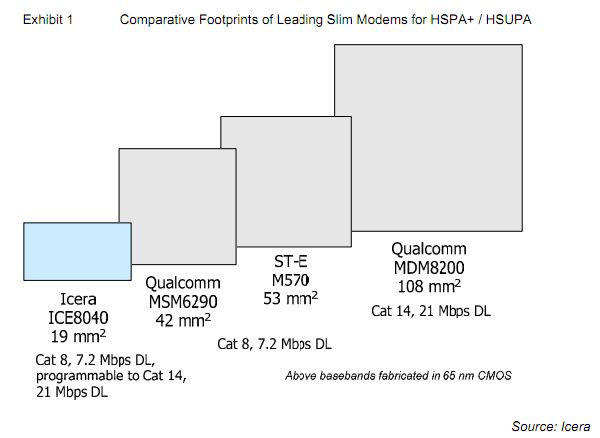NVIDIA to Acquire Icera, Adds Software Baseband to its Portfolio
by Anand Lal Shimpi on May 9, 2011 9:43 AM EST- Posted in
- Smartphones
- Tegra 2
- Mobile
- SoCs
- NVIDIA
Late last year Intel announced the intention to acquire Infineon’s Wireless Solutions business, highlighting an important trend in the application processor space: those determined to lead in the smartphone/tablet SoC market have an intense desire to control as much IP as possible. It’s not enough to simply bundle licensed IP blocks, acquiring the IP is the first step towards consolidating the market.
It started years ago with the acquisition of companies that made audio and video decoders. Qualcomm even purchased ATI’s Imageon GPU business, again with the mindset that if you don’t own your IP, you’re no different than just another competitor who licenses it.
Qualcomm itself has done very well as it has a rare combination of owning a considerable amount of IP within its application processor but also having a successful cellular baseband business. Qualcomm designs its own CPU cores (based on ARM instruction sets), its own GPU cores and likely controls much of the other IP going into its SoCs. On top of all of that, Qualcomm designs its own modems which can be both integrated into its application processors or used externally as a separate chip.
Qualcomm modems have been used in many of the smartphones we’ve played with lately including the HTC Thunderbolt and the Droid Charge.
Having an extensive baseband portfolio is no different for a player in the app processor space as owning your own chipset business was for Intel in the early 2000s. If you can provide your customers (smartphone/tablet vendors) with a platform rather than individual chips there’s the potential to market synergies between your offerings and then of course you can sell more chips to the same customer rather than sending that business elsewhere. Eventually this approach drives the individual vendors of various IP out of business as power is consolidated in the hands of the strongest SoC players.
Today NVIDIA announced that it too is going to play in this game with the acquisition of Icera. The acquisition is expected to close in 30 days and is worth $367 million in cash.
Icera’s modems aren’t too common in high end smartphones. A quick look through its product offering shows a strong focus on mobile broadband devices (e.g. USB modems), however it’s possible that Icera simply could never break into the handset market - something NVIDIA can help address with its recent success on the back of Tegra 2. It’s clear that eventually integrating Icera’s technology into Tegra SoCs now becomes an option which, assuming there are no fundamental issues with Icera’s baseband designs, would obviously increase its presence in the handset space.
What Icera offers that’s unique is what it calls a software baseband. All cellular baseband processors require some sort of on-board processing, which is usually handled by a licensed ARM core, fixed function logic or combination of the two. Icera’s baseband chips feature its own custom designed microprocessor (something Icera calls its DXP - Deep Execution Processor) that can be upgraded, through software, to support a wide range of wireless standards.

The Icera Livanto ICE8060 baseband for example supports HSPA category 8 (7.2Mbps) all the way up through category 24 HSPA+ (42Mbps) and 50Mbps multimode LTE. Presumably Icera charges more for the faster software packages, but it does allow its customers to build a single design that’s quickly adaptable to other networks.
Icera argues that its software baseband architecture results in a smaller overall die size and lower power consumption than the competition. If true, this would mean better levels of integration both in an SoC and in a handset as well as longer battery life. That being said, we all know better than to trust a vendor’s claims without hard evidence.
Icera did publish this diagram which shows the size of its baseband IC compared to solutions from Qualcomm and ST-E:
It’s unclear how similar Icera’s approach is to what companies like Qualcomm already do. Given that there’s only a single baseband listed on Icera’s product pages I suspect it’s at least a bit more configurable than the competition. NVIDIA’s press release makes mention of Icera’s patent portfolio, which is likely a big part of what NVIDIA is after in this acquisition.
Today’s announcement is mostly about NVIDIA continuing to take the SoC market seriously. If you believe that those who will ultimately succeed here will own as much of their own IP as possible, then NVIDIA is on the right path.
NVIDIA posted its own blog on the acquisition here.












16 Comments
View All Comments
Alien959 - Monday, May 9, 2011 - link
Just asking if cellular modem uses main CPU to do some of the work, does that mean that it cannot go into deeper sleep mode and use more battery power when idle.Stuka87 - Monday, May 9, 2011 - link
From what I know, the basic connectivity is all done inside the cellular chip itself. The CPU is used when data outside of this needs to be sent or received. So if the phone is not being used, this would probably include things like checking for voice mail, text messages, etc. Basically anything using a higher layer protocol (TCP, etc).But as to the CPU handling the actual connection itself, I do not believe this to be the case.
EJ257 - Monday, May 9, 2011 - link
I definitely noticed an increase in overall DL throughput when I tether my phone to the laptop vs just downloading directly onto the phone. Now is this a matter of the phone's CPU causing a bottleneck or the phone's Flash memory write bottlenecking I'm not sure.If your phone is idle and suspended it will still communicate with the tower to let it know where you are (the phone lets the tower know it's still on and attached) so it knows where to route incoming calls, sms ...etc.
Conficio - Monday, May 9, 2011 - link
The diagram seems to compare older generations of chips. That shoudl make the claim a few years old and its validity might have been overtaken by design changes in current generation of chips.However, an interesting move for NVIDIA.
Penti - Wednesday, May 11, 2011 - link
Many other SoC's also has in-built modems as separate cores on-die. A second ship for baseband is not always needed. So it would be interesting to see if Nvidia is gonna do any single-chip solutions. For example an ST-E U8500 SoC does have built in baseband. RF-transceiver is still needed though.Pessimism - Monday, May 9, 2011 - link
Some company like Intel needs to buy out NVIDIA and fire their arrogant CEO immediately, stemming the tide of shoddy bumpgate products poisoning so many devices.formulav8 - Monday, May 9, 2011 - link
To me nvidia seems to be in a somewhat higher than normal desperate mode. They are getting into markets that no company in their field would have ever thought about 5 years ago. I guess they see their main core busniess going down hill?DigitalFreak - Monday, May 9, 2011 - link
"I guess they see their main core busniess going down hill? "Let's see.
They are effectively out of the chipset market.
Intel is forcing them out of the low end graphics market.
AMD is giving them a very hard time in the mid to high end graphics market.
All they really have going for them now is the mobile / tablet market, and Qualcomm and other chip makers are catching up to the Tegra 2.
happy medium - Monday, May 9, 2011 - link
yea but they still make more profit than AMD.They make tons of money with there professional graphics line.
Stuka87 - Monday, May 9, 2011 - link
Uhm, no they don't. Where did you read this?According to both companies first quarter 2011 results, AMD brought in a profit of $510 million, while nVidia brought in $137 million. Now obviously some of AMD's profit is from the CPU and Chipset side of things, but if broken down, I am sure the ATI side of things brings in more profit than either of those.
Not to mention Dell and Apple both just switched from nVidia to ATI in many of their machines. The new Dell Precisions, Apple MacBook Pros and iMacs are all ATI only.
nVidia is not in a good position currently period.